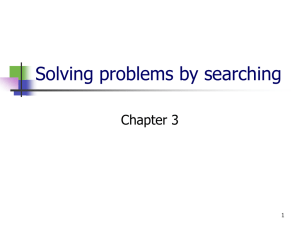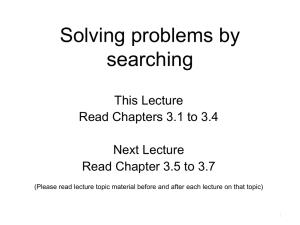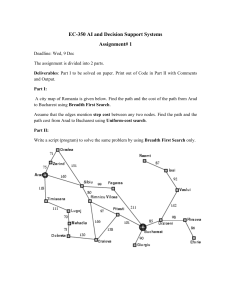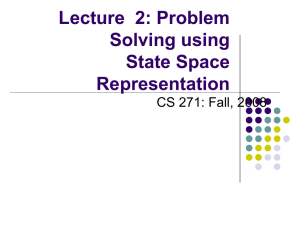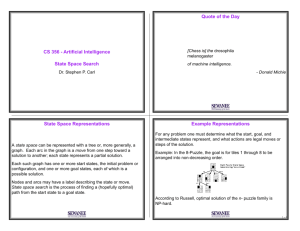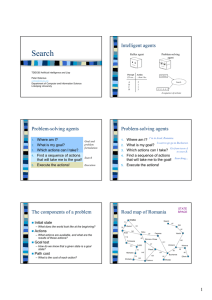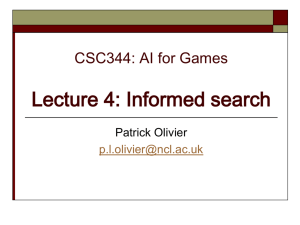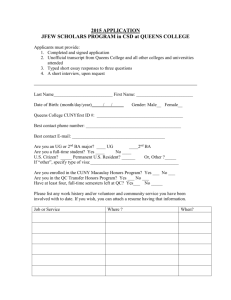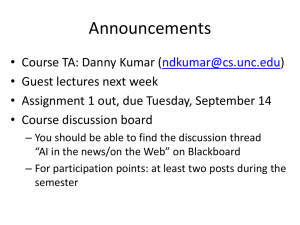Lecture Notes 2
advertisement
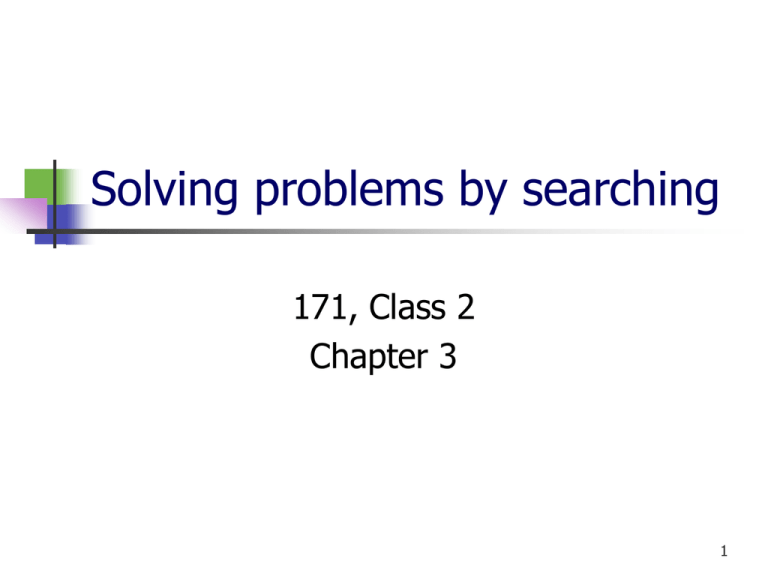
Solving problems by searching
171, Class 2
Chapter 3
1
Overview
Intelligent agents: problem solving as search
Search consists of
state space
operators
start state
goal states
The search graph
A Search Tree is an efficient way to represent the search
process
There are a variety of search algorithms, including
Depth-First Search
Breadth-First Search
Others which use heuristic knowledge (in future lectures)
2
Example: Romania
On holiday in Romania; currently in Arad.
Flight leaves tomorrow from Bucharest
Formulate goal:
Formulate problem:
be in Bucharest
states: various cities
actions: drive between cities
Find solution:
sequence of cities, e.g., Arad, Sibiu, Fagaras, Bucharest
3
Example: Romania
4
Problem types
Static / Dynamic
Previous problem was static: no attention to changes in environment
Observable / Partially Observable / Unobservable
Previous problem was observable: it knew its initial state.
Deterministic / Stochastic
Previous problem was deterministic: no new percepts
were necessary, we can predict the future perfectly
Discrete / continuous
Previous problem was discrete: we can enumerate all possibilities
5
Example: vacuum world
Observable, start in #5.
Solution?
6
Example: vacuum world
Observable, start in #5.
Solution? [Right, Suck]
Unobservable, start in
{1,2,3,4,5,6,7,8} e.g.,
Solution?
7
Example: vacuum world
Unobservable, start in
{1,2,3,4,5,6,7,8} e.g.,
Solution?
[Right,Suck,Left,Suck]
8
9
State-Space Problem Formulation
A problem is defined by four items:
initial state e.g., "at Arad“
actions or successor function S(x) = set of action–state pairs
e.g., S(Arad) = {<Arad Zerind, Zerind>, … }
goal test,
e.g., x = "at Bucharest”, Checkmate(x)
path cost (additive)
e.g., sum of distances, number of actions executed, etc.
c(x,a,y) is the step cost, assumed to be ≥ 0
A solution is a sequence of actions leading from the initial state to a
goal state
11
Vacuum world state space graph
states? discrete: dirt and robot location
initial state? any
actions? Left, Right, Suck
goal test? no dirt at all locations
path cost? 1 per action
13
Example: 8-queen problem
14
Example: 8-Queens
states? -any arrangement of n<=8 queens
-or arrangements of n<=8 queens in leftmost n
columns, 1 per column, such that no queen
attacks any other.
initial state? no queens on the board
actions? -add queen to any empty square
-or add queen to leftmost empty square such
that it is not attacked by other queens.
goal test? 8 queens on the board, none attacked.
path cost? 1 per move
15
Example: robotic assembly
states?: real-valued coordinates of robot joint
angles parts of the object to be assembled
initial state?: rest configuration
actions?: continuous motions of robot joints
goal test?: complete assembly
path cost?: time to execute
16
Robot block world
Given a set of blocks in a certain configuration,
Move the blocks into a goal configuration.
Example :
(c,b,a) (b,c,a)
A
A
B
C
C
B
Move (x,y)
17
Operator Description
18
Example: The 8-puzzle
states?
initial state?
actions?
goal test?
path cost?
Try yourselves
19
Example: The 8-puzzle
states? locations of tiles
initial state? given
actions? move blank left, right, up, down
goal test? goal state (given)
path cost? 1 per move
[Note: optimal solution of n-Puzzle family is NP-hard]
20
The “8-Puzzle” Problem
1
Start State
2
4
6
7
5
8
1
2
3
4
5
6
7
Goal State
3
8
1
2
3
4
5
6
7
8
22
State space of the 8 puzzle problem
23
The Traveling Salesperson Problem
Find the shortest tour that visits all cities
without visiting any city twice and return
to starting point.
C
State: sequence of cities visited
B
S0 = A
A
D
F
E
24
The Traveling Salesperson Problem
Find the shortest tour that visits all cities
without visiting any city twice and return
to starting point.
C
State: sequence of cities visited
B
S0 = A
A
D
F
SG = a complete tour
{a, c, d }
{( a, c, d , x) | X a, c, d }
E
25
The state-space graph
Graphs:
Search graphs:
States are nodes
operators are directed arcs
solution is a path from start to goal
Problem formulation:
nodes, arcs, directed arcs, paths
Give an abstract description of states, operators, initial state
and goal state.
Problem solving:
Generate a part of the search space that contains a solution
26
Tree search algorithms
Basic idea:
Exploration of state space graph by generating
successors of already-explored states (a.k.a. expanding
states).
Every states is evaluated: is it a goal state?
27
Tree search example
28
Tree search example
29
Tree search example
30
Implementation: states vs. nodes
A state is a (representation of) a physical configuration
A node is a data structure constituting part of a search tree
contains info such as: state, parent node, action, path cost
g(x), depth
The Expand function creates new nodes, filling in the
various fields and using the SuccessorFn of the problem
to create the corresponding states.
31
Search strategies
A search strategy is defined by picking the order of node
expansion
Strategies are evaluated along the following dimensions:
completeness: does it always find a solution if one exists?
time complexity: number of nodes generated
space complexity: maximum number of nodes in memory
optimality: does it always find a least-cost solution?
Time and space complexity are measured in terms of
b: maximum branching factor of the search tree
d: depth of the least-cost solution
m: maximum depth of the state space (may be ∞)
32
Searching the search space
Uninformed Blind search
Breadth-first
uniform first
depth-first
Iterative deepening depth-first
Bidirectional
Branch and Bound
Informed Heuristic search (next class)
Greedy search, hill climbing, Heuristics
33
Next time
Search Strategies
Questions?
34
